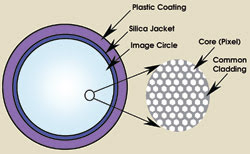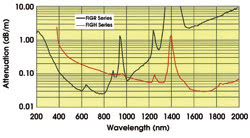Customization of optical fiber leads to new applications in monitoring, manufacturing and research.
Rob Walker and Neil Bessant, Fujikura Europe Ltd.
For remote or semiflexible viewing systems, ultrathin image fiber delivers vision to previously inconceivable locations. Until recently, applications for this type of optical fiber have been in the medical industry, primarily in endoscopes. Because of the versatility of the image fiber, however, it is meeting a variety of specialized demands.

An image fiber transmits a coherent picture from one end to the other.
Conventional telecommunications fiber typically is constructed from silica glass and features a single doped core, a pure silica cladding, a coating and possibly a 250- or 900-μm-diameter outer jacket. The fiber is drawn in a single strand from a preform rod and put onto reels or into cables, depending on the application. Wavelengths of telecommunications fiber range typically from about 850 to 1550 nm to enable optimum data transmission.
Image fiber, too, is made of silica glass. The multiple cores are pure silica or are doped with germanium, and they share a common cladding that is doped with fluorine. The cores, or pixels, are approximately three times thinner than the core of a single-mode telecom fiber; a 1600-pixel fiber has an outer diameter of approximately 210 μm, and a 100,000-pixel one has an outer diameter of 1700 μm. The fiber is drawn in a manner similar to that used in the production of telecom fiber, then cut and bundled into a silica tube to make a preform. It can bend from 200 to 20 mm in radius.

Image fiber, like telecommunications fiber, is made of silica glass but features multiple cores that share a common cladding. The cores, or pixels, are approximately three times thinner than the core of a single-mode telecom fiber.
The versatility of image fiber is partially the result of its ability to function at wavelengths from the UV to the near-IR. Additionally, it can be coated for special handling requirements and for resistance to temperature, chemicals or radiation. Radiation-resistant fiber is suitable for use in environments where electronics-based optical solutions are not viable, such as monitoring nuclear waste disposal in storage facilities. To make the fibers heat-resistant, a chemical-resistant polyimide coating that can withstand temperatures up to 300 °C is applied. This is especially useful for manufacturers designing medical equipment for applications in which autoclave sterilization is necessary.
New uses
The technology behind ultrathin image fiber is not new, but manufacturers and designers increasingly are seeking to expand into new imaging applications. With its customizable features, the fiber can be used to meet a variety of specific application requirements. One important area has been in the field of biomolecular research. Scientists are now using the fiber in confocal microscopes for fluorescence imaging of cells and proteins at the molecular level.

The typical transmission characteristics of the ultrathin image fiber are illustrated. FIGH is Fujikura Image Guide High Resolution series fiber, and FIGR is Fujikura Image Guide Radiation-Resistant series fiber.
In the automotive sector, the fiber has been used to perform quality checks inside an engine before initial testing. Previously, the manufacturers employed rigid rod-lens-based or video imaging systems.
Similarly, in the testing and maintenance of car and jet engines and steam and gas turbines, industrial endoscopes can be used where access is limited or when there is not time to dismantle components. The advantage is that image fiberscopes are flexible, whereas rigid rod-lens-based systems are not. The flexibility helps them reach into previously inaccessible areas.
There are other possible applications for image fiber. For instance, using infrared wavelengths, it could be employed to take snapshots of the blades inside gas or steam turbines, which would minimize, if not eliminate, the need to shut down power stations or refineries for such maintenance checks. The challenge here, however, is for a manufacturer to design a borescope that could withstand the associated high temperatures.
As expertise and knowledge increase, custom solutions will be found in countless applications across many industries.
Meet the authors
Rob Walker is development manager at Fujikura Europe Ltd. in Chessington, UK; e-mail: [email protected]. Neil Bessant is sales and marketing manager; e-mail: [email protected].